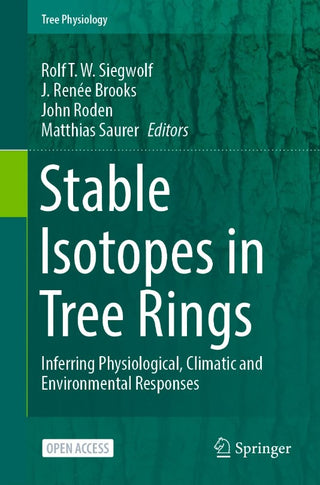Stable Isotopes in Tree Rings
- Unit price
- / per
-
Author:SIEGWOLF Rolf / BROOKS Renee / RODEN John
-
ISBN:9783030926977
-
Publication Date:June 2022
-
Edition:1
-
Pages:773
-
Binding:Hardback
-
Publisher:Springer Verlag
-
Country of Publication:The Netherlands


A Back Order button means that we don’t have the book in stock at our store. It may already be on order – or we can order it for you from a publisher or distributor at no additional cost.
As we source items from around the globe, a back-order can take anywhere from 5 days to several weeks to arrive, depending on the title.
To check how long this might take, you’re welcome to contact us and we can provide an ETA or any other information you need. We recommend checking the timeframe before committing to an online order.
Stable Isotopes in Tree Rings
- Unit price
- / per
-
Author:SIEGWOLF Rolf / BROOKS Renee / RODEN John
-
ISBN:9783030926977
-
Publication Date:June 2022
-
Edition:1
-
Pages:773
-
Binding:Hardback
-
Publisher:Springer Verlag
-
Country of Publication:The Netherlands
Description
This Open Access volume highlights how tree ring stable isotopes have been used to address a range of environmental issues from paleoclimatology to forest management, and anthropogenic impacts on forest growth. It will further evaluate weaknesses and strengths of isotope applications in tree rings. In contrast to older tree ring studies, which predominantly applied a pure statistical approach this book will focus on physiological mechanisms that influence isotopic signals and reflect environmental impacts. Focusing on connections between physiological responses and drivers of isotope variation will also clarify why environmental impacts are not linearly reflected in isotope ratios and tree ring widths. This volume will be of interest to any researcher and educator who uses tree rings (and other organic matter proxies) to reconstruct paleoclimate as well as to understand contemporary functional processes and anthropogenic influences on native ecosystems. The use of stable isotopes in biogeochemical studies has expanded greatly in recent years, making this volume a valuable resource to a growing and vibrant community of researchers.
Adding product to your cart
You may also like
A Back Order button means that we don’t have the book in stock at our store. It may already be on order – or we can order it for you from a publisher or distributor at no additional cost.
As we source items from around the globe, a back-order can take anywhere from 5 days to several weeks to arrive, depending on the title.
To check how long this might take, you’re welcome to contact us and we can provide an ETA or any other information you need. We recommend checking the timeframe before committing to an online order.
You may also like
You may also like
-
This Open Access volume highlights how tree ring stable isotopes have been used to address a range of environmental issues from paleoclimatology to forest management, and anthropogenic impacts on forest growth. It will further evaluate weaknesses and strengths of isotope applications in tree rings. In contrast to older tree ring studies, which predominantly applied a pure statistical approach this book will focus on physiological mechanisms that influence isotopic signals and reflect environmental impacts. Focusing on connections between physiological responses and drivers of isotope variation will also clarify why environmental impacts are not linearly reflected in isotope ratios and tree ring widths. This volume will be of interest to any researcher and educator who uses tree rings (and other organic matter proxies) to reconstruct paleoclimate as well as to understand contemporary functional processes and anthropogenic influences on native ecosystems. The use of stable isotopes in biogeochemical studies has expanded greatly in recent years, making this volume a valuable resource to a growing and vibrant community of researchers.
-
-
Author: SIEGWOLF Rolf / BROOKS Renee / RODEN JohnISBN: 9783030926977Publication Date: June 2022Edition: 1Pages: 773Binding: HardbackPublisher: Springer VerlagCountry of Publication: The Netherlands
This Open Access volume highlights how tree ring stable isotopes have been used to address a range of environmental issues from paleoclimatology to forest management, and anthropogenic impacts on forest growth. It will further evaluate weaknesses and strengths of isotope applications in tree rings. In contrast to older tree ring studies, which predominantly applied a pure statistical approach this book will focus on physiological mechanisms that influence isotopic signals and reflect environmental impacts. Focusing on connections between physiological responses and drivers of isotope variation will also clarify why environmental impacts are not linearly reflected in isotope ratios and tree ring widths. This volume will be of interest to any researcher and educator who uses tree rings (and other organic matter proxies) to reconstruct paleoclimate as well as to understand contemporary functional processes and anthropogenic influences on native ecosystems. The use of stable isotopes in biogeochemical studies has expanded greatly in recent years, making this volume a valuable resource to a growing and vibrant community of researchers.
-
Author: SIEGWOLF Rolf / BROOKS Renee / RODEN JohnISBN: 9783030926977Publication Date: June 2022Edition: 1Pages: 773Binding: HardbackPublisher: Springer VerlagCountry of Publication: The Netherlands
-



